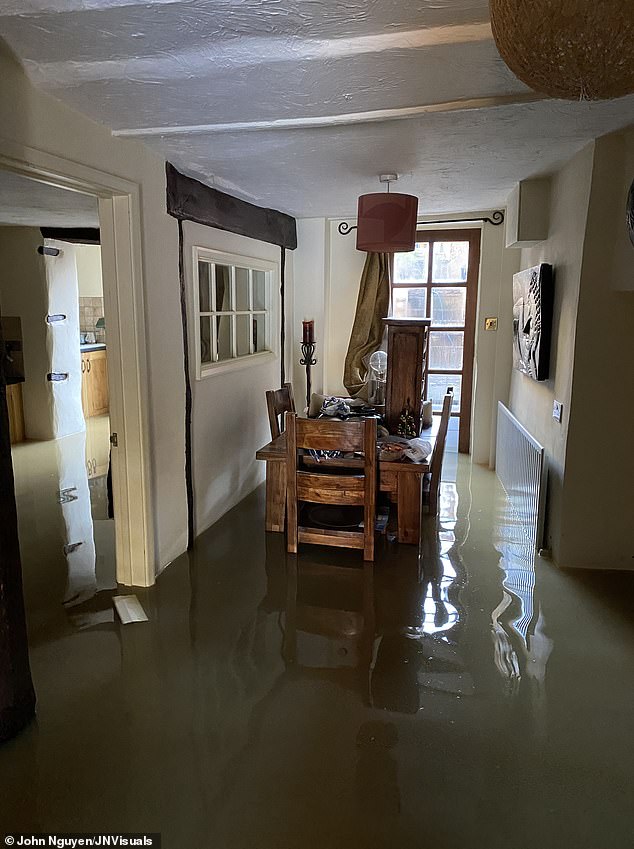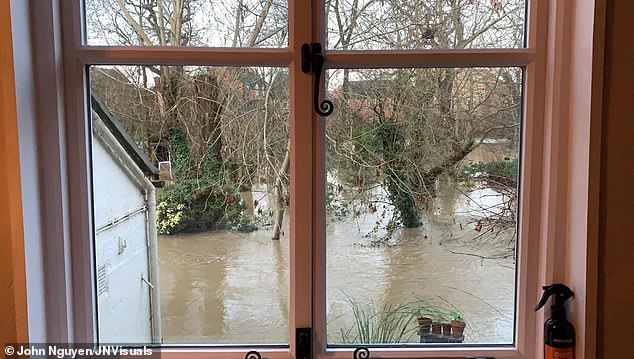There’s a plumber connecting the dishwasher in Nick Robinson’s kitchen, plus a newly installed bespoke counter and a smell of fresh paint.
After eight months, his Buckingham home is nearly ready for him to move back into. Yet memories of the sewage that spewed through drains outside and flooded his floors last November are not so easily fixed.
‘You see horrible things floating around – faeces, lavatory paper. Whatever anyone’s put down, it comes into my house,’ says Nick, 65. Worse, this wasn’t a one-off, never-to-be-repeated occurrence. ‘It’s happened four times now,’ he says.
For Nick and his neighbours, the sense of dread as soon as it starts to rain has become horribly familiar.
Last November, six hours after the drains overflowed, the nearby River Ouse – which snakes through this otherwise picturesque market town and is contaminated with yet more sewage – broke its banks.
At which point the retired civil servant recalls his 17th-century listed property ‘filled up like a swimming pool’. It’s taken all this time to restore.
The mess, he says, is largely the fault of the local council and water company. Not only have they failed to improve the town’s decrepit sewage system, but they have also approved, built and connected even more houses to it, straining it to breaking point.
But Buckingham isn’t the only town suffering under the weight, literally, of too much waste. The complex and shambolic situation here reflects a wider national crisis in which councils are under ever-greater pressure to meet Labour’s target to build 1.5 million homes by 2029 – despite the fact water systems across the country are no longer fit for purpose.

Flooded fields near Buckingham after the Padbury Brook burst its banks

A car is submerged by water on Ford Street in Buckingham. Foe residents the sense of dread as soon as it starts to rain has become horribly familiar
This week alone, residents in Clapham and Bermondsey have seen their streets submerged after burst pipes – overseen by embattled Thames Water – sent flood water surging through south London.
Buckingham’s sewage facility has been at capacity, unable to cope with more waste, since 2015. Yet more than 1,000 new houses have been built in the past decade regardless, and this May Buckinghamshire Council approved the development of 153 more in the adjoining village of Maids Moreton, reliant on the same sewage system.
And there are four other Buckingham developments currently going through the planning process which, if approved, would mean a total of 1,108 extra houses dependent on a system so overwhelmed, it is not only dumping sewage into the River Ouse and creating an environmental disaster, but also routinely destroying homes and businesses, and leaving locals up to their waists in effluence.
Predictably, however, none of the authorities involved appear prepared to accept the blame. Buckinghamshire Council is in charge of the ancient combined pipes collecting sewage and rainwater and connecting homes to the sewage system.
Anglian Water is supposed to ensure there is adequate sewage capacity – but has no funding to upgrade Buckingham Water Recycling Centre (WRC), the sewage plant that services the town.
Surprisingly, however, it claimed there is capacity for the Maids Moreton development – with the ludicrous caveat that houses shouldn’t be occupied after they’re built. Meaning the developers are allowed to sell the properties but the buyers aren’t allowed to move in – leaving the properties empty indefinitely.
Elsewhere in the country, the picture isn’t much better. Sewage spills across Britain more than doubled in 2024 compared to 2022, from 1.75 million hours to 3.6 million hours.
In May Ofwat, the regulator for the water and sewerage sectors in England and Wales, fined Thames Water nearly £123 million for breaching rules relating to its wastewater operations.
It came as Thames reported that sewage leaks rose by a third last year as it recorded an astonishing pre-tax loss of £1.65 billion. Last week, Ofwat also found South West Water repeatedly spilled sewage and the company agreed to pay £24 million in settlements. Ofwat is still investigating Anglian Water.
It doesn’t even take very heavy rainfall for the homes in Buckingham to bubble up with dirty sewer water, says Nick’s neighbour Cari Bibb, 64, secretary of local campaign group Flood Action 4 Buckingham (FA4B).
‘Even when the river’s low it can come through the drains. Manhole covers start popping. Then the road starts flooding.’
Worst of all is ‘knowing it could happen again and nothing is being done’.

Cari Bibb’s smart kitchen is submerged in a lake of dirty sewage water

He says the worst part is ‘knowing it could happen again and nothing is being done’
The town’s oldest houses in the historic centre seem to be worst affected by the developments. Julian and Janice Scarr have lived in their 17th-century home close to the river since 2020.
It flooded in 2007, 2020 and three times last year, culminating in the big flood in November 2024, and their tiled floors – nobody I meet here has carpets – being submerged under 3ft of ‘dark brown’ water. ‘It rules our lives now,’ says Julian, 58, a company director.
The couple have spent thousands on pumps which, during a flood, they manned for 48 hours straight in a desperate attempt to keep water levels low. They monitor the river levels religiously and, when they rise, move everything they can upstairs. Of course, not everything can fit. Last November Julian threw out two Heal’s sofas worth £2,500, which soaked up contaminated water ‘like sponges’.
What does Anglian Water do to help? ‘Nothing. They say because it’s a combined rainwater and sewage system it isn’t anything to do with them. They have an argument between themselves and Buckinghamshire Council over whose responsibility it is. They are absolutely useless. No one comes to clean the road. We walk through contaminated water until the rain washes it off.’
The Scarrs were due to exchange contracts to sell their house two days after their home flooded last November – but, perhaps unsurprisingly, the buyers pulled out. ‘Our properties are unsaleable and will only get worse because of the houses they’re building.’
Today the River Ouse is low, which obviously reduces the risk of flooding, but ‘there is a decrease in the dilution effect for sewage which makes the pollution doubly potent’, says Dr Justin Neal, a solicitor at environmental charity Wildfish, which has been granted a judicial review at London’s High Court this October, challenging the Maids Moreton planning permission. In other words, the sewage in the river is more concentrated and harmful to wildlife.
I walk across the bridge in the town centre with local Ian MacKenzie, 62, who is on the FA4B committee and has lived here since 1994. ‘When we first moved here it was clear,’ he says, pointing at the dark brown water in the river below. ‘If it rains hard, it makes you feel sick.’
Data from Anglian Water shows sewage was being dumped into the river from one overflow site for 24 hours continuously during the flood last November.
Roger Elliott’s five-bedroom home sits near to another site, which he says he has seen discharge sewage ‘20 times, easily’ into the river in the 15 years he’s lived there. It contains ‘nappies, sanitary towels, everything people shouldn’t throw down drains’.
His brick home, set close to the river, has flooded three times. A former builder, 64-year-old Roger recalls the day before Christmas Eve in 2020, when he discovered water bursting through the floor tiles of his downstairs bathroom to waist height ‘like somebody had got a hose pipe underneath’.
It took four days for the water to drain away – which was really only the start of the disaster. ‘It’s all the mess that’s left.’ The council did nothing to help, he says.
Livelihoods are being destroyed as well as houses. When Anita Stubbings’ beauty salon flooded in 2020, she recalls boxes of wax strips floating on ‘dirty brown, disgusting water’ that smelt ‘putrid’. ‘It was up to my thigh. I went into instinct mode. I wanted to salvage my business,’ says Anita, 55, a mother of one. Since then her insurance has become four times more expensive.

The view from Roger Elliott’s home, which has been flooded with sewage-contaminated water several times

Antonia Hoyle with Ian MacKenzie, one of the many people in Buckingham who has to regularly cope with the flooding
Given the obvious devastation, why has Anglian Water not been more vociferous in its objection to the new housing developments?
This March, Anglian said it was withdrawing its objection to the Maids Moreton development, because funding had ‘been confirmed for the Buckingham WRC’.
Yet in response to a Freedom of Information (FoI) request this May, Anglian said ‘there is currently no dedicated scheme for upgrades at Buckingham WRC’.
It gets more contradictory. In another internal memo this March, also released under the FoI request, it said the Maids Moreton development, run by David Wilson Homes South Midlands, part of the UK’s largest housebuilder Barratt Redrow, would ‘create an unacceptable risk of flooding to our existing customers and the environment’.
Yet its public pre-planning report a month later claims the exact opposite – that ‘the additional foul flow from the proposed development would not create an unacceptable risk of flooding to our existing customers and the environment’.
This March the water company said the sewage system lacked capacity for another development, this one for 220 houses at Bourton Road in Buckingham.
Yet whether this lack of capacity is even seen as a stumbling block depends on who you ask. A representative from Bourton Road’s developers Bloor Homes told me Anglian Water ‘have confirmed that funding has been secured for future upgrades to their 2025-2030 investment programme, which includes the WRC. As such, they have raised no objection to our proposals subject to a planning condition that ensures any necessary improvements are delivered prior to occupation’.
Which is that curious caveat again – just as with the new Maids Moreton development, if the council approves planning, Anglian Water recommends nobody is allowed to move into the Bourton Road houses until there is sewage capacity for them.
It’s a strategy that has been recently adopted in Norfolk, too. Yet everyone I speak to agrees this is a nonsensical stipulation: is any council under pressure to meet housing targets really going to allow homes to sit empty for years?
A spokesman for Maids Moreton developers David Wilson Homes South Midlands said: ‘We will ensure a programme of any wastewater upgrades required to support the development has been agreed with Anglian Water.’
A spokesman for Anglian Water said it had removed its initial objections to the Maids Moreton development because Ofwat has made an allowance for growth schemes. They added: ‘Although there is currently no dedicated scheme for upgrades at Buckingham WRC, we are currently reviewing and prioritising our growth portfolio for delivery over the next five years.’
Peter Strachan, Buckinghamshire Council’s deputy leader and cabinet member for planning, said the council ‘follows the planning process rigorously as determined by nationally set guidance and legislation’.
Of the Maids Moreton development, he reiterated the homes can be built and sold, ‘but they cannot be occupied until it’s proven that the local wastewater system can cope with the additional usage’.
A mess as murky as the contaminated River Ouse, then. Although this much is clear – without a better sewage system, the river will only grow more polluted with every new housing development.
And residents will be forced to watch, and wait, for it to burst its banks and cover their homes in filth again.












